#Kāne Kanaloa
Text

I love when I get to play with new gorgeous cc from my darling @joliebeancc 💛 ( free Aug 9th )
#Unhand your Captain!#extra plott#sunny plott#kāne kanaloa#hello teens#also i tried out the heatstroke blush#its really good! but i dont know if my sims are cunty enough to pull it off
90 notes
·
View notes
Note
have you been asked to review the Tapu pokemon yet?
As a whole, I really like the Tapus. It's neat to have one guardian per Alolan island, and the designs themselves are well thought out. I really like how each one has a set of white triangular markings with a darker border, which allows each one of them to be very distinctive with unique designs and palettes while also making sure all three look like they belong together in a group. This is also enhanced by them carrying tiki-inspired masks, with each one being based on a different animal that also influences the creature itself to some degree. Good stuff.
Thematically, the Tapus are also based off of the four main Hawaiian gods (Koko, Lele, Bulu, and Fini seem to be based off of Kūkaʻilimoku, Kāne, Lono, and Kanaloa respectively). I'm obviously not Hawaiian so I don't feel qualified to judge these guys on accuracy, though it seems like Tapu Koko is the most on-point with the feathered look while Tapu Fini is the least, having little to do with the deity it's based off of aside from a vague connection to the ocean.
Regardless, all of these designs are distinct and do a good job standing out from other legendaries, as well as tying back into their region. There was clearly a lot of thought that went into them in terms of both functionality and visual aesthetics.

Tapu Koko is my personal favorite of the bunch. Vaguely based off a rooster (side note: I'm amazed we don't have a rooster 'mon yet. I guess Blaziken counts but it's only a rooster in the vaguest sense of the word), it sports feathers, a beak-like structure on its face, and a mask that it forms a beak with using its pincer-like hands. Really neat! I also like the mohawk becomes the rooster's comb when the mask is closed.

The orange and yellow palette is also nice, as it's very high-contrast and pops well against the black body. My only nitpicks would be that the two pairs of chest markings feel a bit too busy, as do the lines in the yellow part of the eye (though granted, they all have those). Otherwise, this is a very neat design.
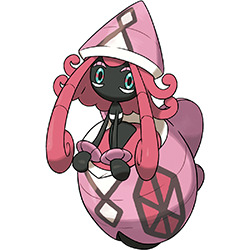
I like Tapu Lele because it looks all cute and pretty and then it turns out it's an incredibly cruel nature deity that does not care about the suffering it causes. It and Beautifly should be friends.
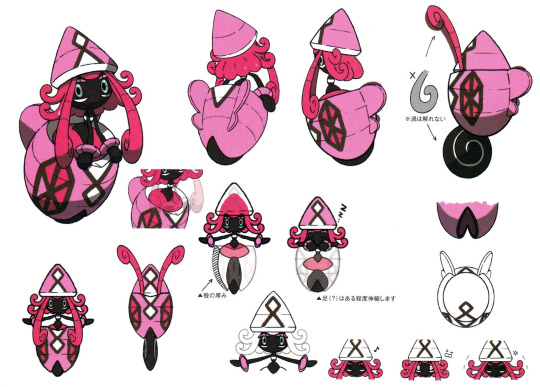
Anyway, Tapu Lele is meant to resemble a butterfly head, with the hair curls becoming antennae and a tentacle emerging from the bottom that resembles a proboscis, along with two wing-like structures on the back. I don't think it reads quite as clearly as some of the others, and I do wish the body took after its animal more (the creature itself having no insect-like traits, compared to the other Tapus where you can see the animal influence outside of the masks), but it's still neat.

Tapu Bulu probably resembles its animal the most in terms of body shape, having a bull's signature nose piercing and hooves, as well as horns. Most interesting is the long tail, which not only matches the hooves but becomes the bull's nose ring when the mask closes.
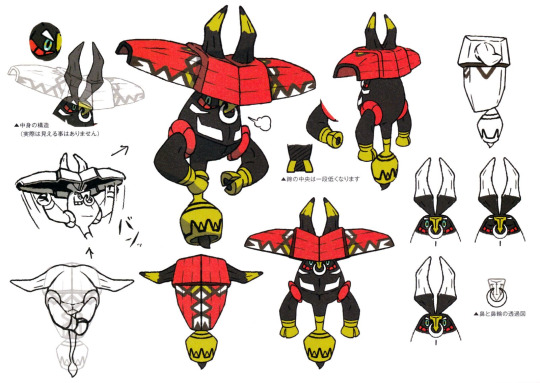
The colors are nice and high-contrast, but I do wish it had been green instead of red. Koko is yellow and orange, Lele is pink and red, and Fini is purple and blue. Having Bulu be red and gold feels too similar to Lele, even if it fits the angry bull idea. It also would've made sense from a typing perspective, as Tapu Bulu is the grass-type of the group (even the horns kind of look like pencils/wood).
Otherwise I don't have any real complaints, outside of the face markings feeling a bit busy, as you have the nose, ring, and three different eye markings. I feel like they could've easily dropped the white eye markings and not lost anything.

And finally, Tapu Fini is probably my least favorite of the group, though it's still a good design. I like the body shape (kind of siren-like, though I don't know if that was intentional) with fin-shaped accents in the hair, on the hands, and on the body.
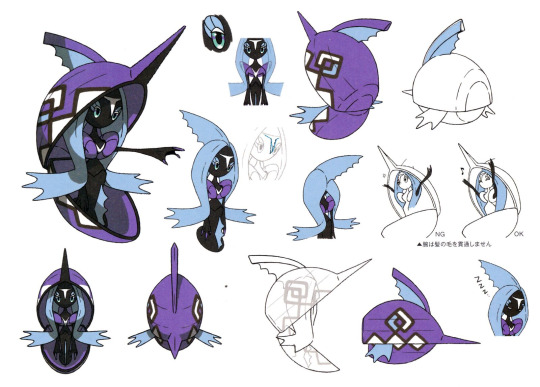
When it closes its mask it resembles a swordfish of sorts, with the hair strands becoming the side fins and the hair fin slotting into the mask's purple ridge to form a dorsal fin. Something about the fish itself feels a little off though; maybe it's just that it lacks a tail fin, or maybe it just looks a bit too plain compared to the others because it's meant to be viewed more from the side. Still a pretty solid design all around though.
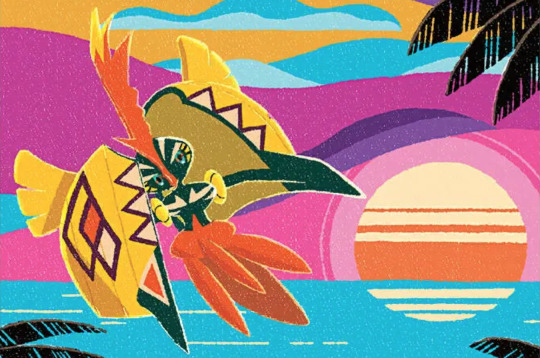
Anyway, overall, I think these guys are great. They're cohesive but distinct, have unique visuals and themes that set them apart from other legendaries, and designs that work from both a visual and mechanical standpoint. Good stuff.
98 notes
·
View notes
Text
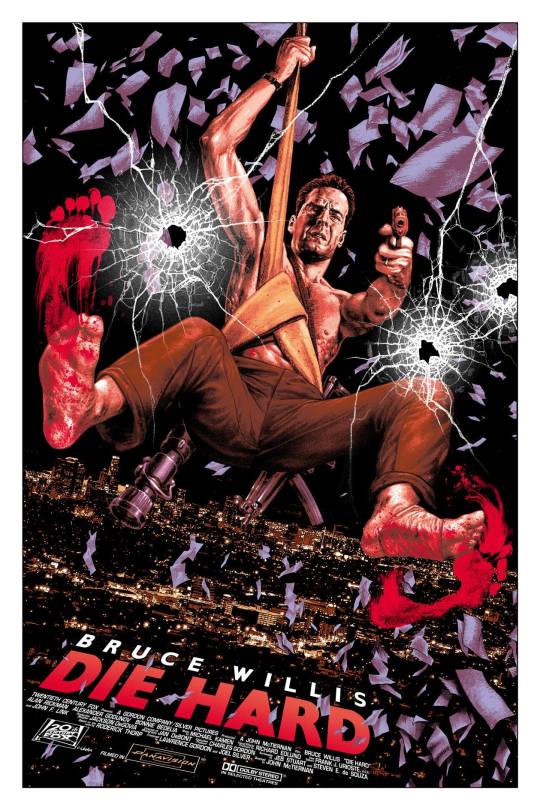
youtube
youtube
"Right out of the 👺 terrorist playbook."
🕎✝️🛐 Father in Heaven, "cancel Christmas" on the many REAL 👺 Hans Gruber incarnations, in 🌎 the world. 🙈🙉🙊 Decrease ignorance.

Payback FROM ⚰️ BEYOND the grave: MUST 🪖 WATCH.
"In today's world, people are expected to apologize over views on heterosexuality, but there's no apology for one of the worst military disasters at least in my lifetime, and they're calling it a success."
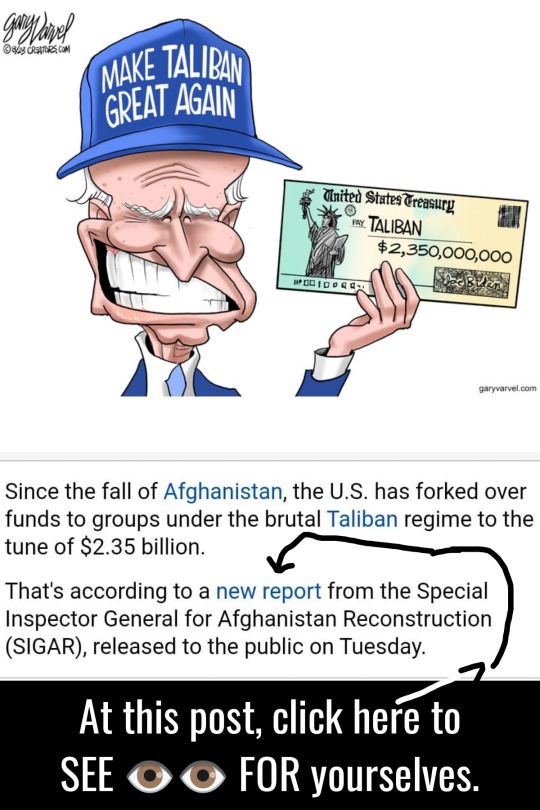
Must 🧐 GET 👊🏾 INVOLVED.
DON'T MISS THIS ⬆️ INTEL.

youtube
An 🎪🤡🚳 EVIL 👺💩 RIDE.

MUST 💉⚰️ AVOID, 💯%: Moving ⏩ ahead, a booster vax CAN expedite 💀 death.

youtube
Let's ✝️🛐 pray for 🏝️ Maui.
Fire survivors, MANY who are elderly, now FACE disruption during what are traditionally peaceful days while riding 📴 into their sunset.
Who you direct prayers to can make ALL the difference.
Spiritual takeaway: DRASTIC changes can happen to ALL ages up until your last breath.

youtube
Fewer opportunities remain: 🔚 times are approaching‼️

WHEN will the GUILTY pay?

Everything is accelerating. We're nearing the conclusion.

youtube
Ever feel "out of ⛽ gas", in the middle of a country road? 🇺🇸 Americans are stuck with assassins in-charge, for now.
"Make way in the wilderness".
1 note
·
View note
Text
The Gods of Hawaiian Mythology
The Hawaiian religion is both animistic and polytheistic, meaning its followers believe in a natural world that is imbued with spirits, who are ruled over by gods and goddesses. Here’s a look at some of the major gods of Hawaiian mythology:
I’o is the unmanifest source of creation. It was this unseen entity who breathed Mana, a divine energy, across the Po (darkness), bringing life to all things, living and non-living.
Kāne is the god of procreation who brings prosperity to the wildlands of Hawaii. He also helped create humans from red and white clay, gifting them with life.
Ku is the god of war. He saved the other deities on numerous occasions when wars broke out. Ku, who was known as the “eater of islands” for conquering so many islanders.
Lono is the god of cultivated foods, education and music. Some say that after an incident with his first mortal wife Kaikilani, the rain was Lono’s tears over his loss of her.
Kanaloa is the god of the sea. Legends state that he led a horde of spirits against the other gods who then banished them to the underworld as punishment.
Wākea is the sky father and ancestor of the Hawaiian people. He holds dominion over the daylight symbolises the sky from which the sun and rain fertilize the earth.
Kamohoaliʻi is a shark god who swims around the islands of Hawaii. He is said to have guided the ships of the islanders from the mainland to their homes in Hawaii.
Pakaʻa is the god of the wind. He has the ability to create powerful gales or calm the ocean with a soft breeze.
Kahoali is the god of sorcery. His favourite drink was kava served with a human eyeball in it. He could construct figurines and bring them to life to do his bidding.
Kamapua’a is the god of wild boars, whose name literally means “hog child.” He was born on Oahu to humans and could transform from human to hog.
Kaulu is a trickster who is at times violent & destructive. He is known for being extremely powerful, both physically and with magic, and can shapeshift into objects or animals.
Maui is a benevolent demigod who holds dominion over the sun. When the sun rose and set too quickly, Maui tamed it and extended the length of the day.
To read a more indepth article about the Hawaiin Gods, subscribe to my Patreon page & gain a deeper insight into the world of mythology: www.patreon.com/HumanOdyssey

#hawaii#gods#polytheism#mythology#hawaiian#I’o#kāne#ku#lono#kanaloa#wākea#kamohoaliʻi#pakaʻa#kahoali#kamapua’a#kaulu#maui
7 notes
·
View notes
Photo

Nightmarchers from Hawaiian mythology.
On the nights honoring the Hawaiian gods Kāne, Kū, Lono, or on the nights of Kanaloa they are said to come forth from their burial sites, or to rise up from the ocean, and to march in a large group to ancient Hawaiian battle sites or other sacred places. The legend says the night marchers are normal-size warriors, dressed for battle, carrying spears, clubs, and some are beating war drums and blowing tones from conch shells, to announce the advancing of their march. According to the myth, they are suspended in air; their feet do not touch water or ground as they traverse through the night, and they leave no evidence of their visitations.
They march in darkness after sunset and march as a group continuously until just before sunrise. Anyone living along their path may hear chanting, sounds of blown conch shell tones, and marching noises in the night. The following signs are a foul and musky “death-like” odor, and torches getting brighter and brighter as the night marchers get closer. Nightmarchers might appear during the day if they are to escort a dying relative to the spirit world.
Ancient Hawaiian beliefs state that any mortal looking upon or being seen in defiance toward the marchers will die violently. Barriers placed in the path of night marchers will not deter them. Some people maintain that if the mortal lies motionless, face down on the ground, they are showing proper respect, fear, and deference to the night marchers, and they will be spared. Additionally, mortals can avoid harm or death from night marchers by being fortunate to have an ancient ancestor marcher present to recognize them. As they encounter the mortal, they will call out “Na'u!”, which means “mine” in Hawaiian. No one in the warrior procession will harm them.
Legend says planting living ti (Cordyline sp.) shrubs around one’s home is said to keep away all evil spirits and will cause the Nightmarchers to avoid the area. They are said to walk through houses with doors and backdoors placed in a straight line.
Follow @mecthology for more myths and lore.
DM for pic credit.
https://www.instagram.com/p/CTpd5rrvj_B/?utm_medium=tumblr
#Hawaiian#myth#mythology#hawaiian mythology#scary#spirit#ancestral#paranormal#creepy#magic#immortal#folk lore#mecthology#haunted#spooky#supernatural#gods#warriors#undead
12 notes
·
View notes
Note
(Part 4) I think this is the last part, also know that I didn’t add every piece of Hi’iaka’s journey cause that would have taken almost ten asks and I’m just tryna get to the Pele vs her sister part which is right now.
Hiʻiaka whose feelings for Lohiʻau was loyally suppressed in the name of her lover Hopoe eventually returned to the big island with Lohiʻau. On their way to Pele’s abode, the two stopped at where Hiʻiaka’s forest should have been.
And Hiʻiaka wept fiercely as she gazed upon what was left of her home. Ash, stone, rock and darkness. And near the edge where the ashes met the sea was her lover, Hopoe. Hiʻiaka wept harder as all that was hers was now gone. Lohiʻau could only wonder out loud at who could do something like this.
Knowing exactly who, Hiʻiaka then decided to defy her sister and embraced the man who had fallen in love with her. Near the base of Pele’s home, where Pele could clearly gaze upon the world in all directions, Hiʻiaka made her sister witness exactly who Lohiʻau was in love with now.
Pele enraged at her sister’s disrespect cast waves upon waves of lava to cover the loving couple. Hiʻiaka survived the assault but Lohiʻau, just like Hopoe and the Tahitian demigod was turned to stone. Beyond enraged at her elder sister, Hiʻiaka raced up the slopes of Kīlauea and openly defied Pele.
Now with nothing left but their anger, the two goddesses fought. Pele called upon her attendants, her brothers and sisters who were the spirits of explosion, ash, smoke to aid her in her assault against their sister Hiʻiaka. But they had never seen their younger sister so angry, for even they would not aid Pele in her fight. So Pele fought alone.
Waves of lava, ash, smoke and darkness were cast down the slopes of her volcano towards her younger sister. But Hiʻiaka, so consumed by rage was able to deflect, reflect or dodge the elder’s attacks. Eventually Hiʻiaka successfully made it back to the slopes of Halemaʻumaʻu and used her magic, her energy and her staff to attack Pele and Pele’s own ancient staff. Pele’s staff was the same that birthed the volcanoes of Hawaiʻi, and was gifted to her by her uncle the Thunder god. And here Pele was slowly being beat back down in the the depths of her volcanic home by her younger sister.
The roaring of their yells and cries, the thundering of their clashing weapons, the explosions of the skies and lands and the worried wailing of the many siblings of Hiʻiaka and Pele prompted the the cosmos to explode open, and descended the ancient four gods. The great four gods of Hawai’i. Kāne, Kanaloa, Kū, and Lono. And with them, their parents, father sky, Wakea and Mother Earth, Haumea. The six flew down from the heavens and separated the warring sisters, preventing their destruction from consuming the islands.
With the presence of the great four and their parents, the two sisters were forced to talk it out and diminish their anger for if they knew one thing, it was that they would always respect their elders. Theirs parents especially.
Eventually Pele, regretting her actions apologized for her actions and with Hiʻiakaʻs help revived Lohiʻau for he was dead for not that long, hence allowing him to be brought back to life again. And to show her sister how sorry she was, Pele allowed Lohiʻau, to choose which goddess to spend his life with. And with that choice, the two sisters went their separate ways, Pele remained in her home in her volcano while Lohiʻau followed Hiʻiaka back home to Kauaʻi.
Thee end.
Granted there are many different versions of this tale, just know that this was the one I was taught and I’m pretty sure if you asked someone else they would tell you another version. But yes, that was the tale of Pele vs her sister Hiʻiaka, the Goddess of Hula, dance, music, medicine and rebirth. It was through this journey that Hiʻiaka learned her significance as a goddess. For Pele was not only a goddess of destruction, but the goddess of creation, for its her actions that creates new land and a clear new start after tragedy. And it’s Hiʻiaka, the akua of life and rebirth to bring life to the new lands, to the destroyed lands Pele had made. For together they represented the process of creation. New life cannot exist without death. And that’s what they represent together.
Thank you so much that was so interesting 🥺 i really appreciate you taking the time out to tell me the story
3 notes
·
View notes
Text
Hawaiian Religion
Hawaiian religion encompasses the indigenous religious beliefs and practices of the Native Hawaiians. It is polytheistic and animistic, with a belief in many deities and spirits, including the belief that spirits are found in non-human beings and objects such as animals, the waves, and the sky.
Hawaiian religion originated among the Tahitians and other Pacific islanders who landed in Hawaiʻi between 500 and 1300 AD. Today, Hawaiian religious practices are protected by the American Indian Religious Freedom Act. Traditional Hawaiian religion is unrelated to the modern New Age practice known as "Huna."
Deities
Hawaiian religion is polytheistic, with four deities most prominent: Kāne, Kū, Lono, and Kanaloa. Other notable deities include Laka, Kihawahine, Haumea, Papahānaumoku, and, most famously, Pele. In addition, each family is considered to have one or more guardian spirits known as ʻaumakua that protected family.
One breakdown of the Hawaiian pantheon consists of the following groups:
the four gods (ka hā) – Kū, Kāne, Lono, Kanaloa
the forty male gods or aspects of Kāne (ke kanahā)
the four hundred gods and goddesses (ka lau)
the great multitude of gods and goddesses (ke kini akua)
the spirits (na ʻunihipili)
the guardians (na ʻaumākua)
Another breakdown consists of three major groups:
the four gods, or akua: Kū, Kāne, Lono, Kanaloa
many lesser gods, or kupua, each associated with certain professions
guardian spirits, ʻaumakua, associated with particular families

Above image: One side of Puʻukohola Heiau, a Hawaiian temple used as a place of worship and sacrifice.
Prayer
Prayer was an essential part of Hawaiian life, employed when building a house, making a canoe, and giving lomilomi massage. Hawaiians addressed prayers to various gods depending on the situation. When healers picked herbs for medicine, they usually prayed to Kū and Hina, male and female, right and left, upright and supine. The people worshiped Lono during Makahiki season and Kū during times of war.
Histories from the 19th century describe prayer throughout the day, with specific prayers associated with mundane activities such as sleeping, eating, drinking, and traveling. However, it has been suggested that the activity of prayer differed from the subservient styles of prayer often seen in the Western world:
"..the usual posture for prayer – sitting upright, head high and eyes open – suggests a relationship marked by respect and self-respect. The gods might be awesome, but the ʻaumākua bridged the gap between gods and man. The gods possessed great mana; but man, too, has some mana. None of this may have been true in the time of Pāʻao, but otherwise, the Hawaiian did not seem prostrate before his gods.”
Heiau, served as focal points for prayer in Hawaiʻi. Offerings, sacrifices, and prayers were offered at these temples, the thousands of koʻa (shrines), a multitude of wahi pana (sacred places), and at small kuahu (altars) in individual homes.
330 notes
·
View notes
Photo
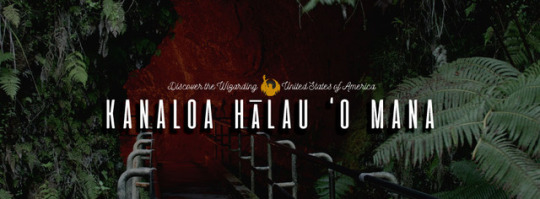
While the seven senior wizarding schools are the best known places for magical education in the United States, the local private schools have produced witches and wizards of the most interesting talent. The magic of the Hawai’ian Islands is odd, old, and adaptive - as is the native Islanders. They were teaching magic amoung their people long before they were visited.
The Hawai’ian Islands didn’t officially become a US state until 1959. Before that, the magic folk from the islands weren’t accepted into Ilvermorny until they became a territory in 1900. Ilvermorny saw very few native witches and wizards attend. It wasn’t until the turn of the 21st century that there was a surge of native Hawai’ians in the population of Ilvermorny. This was largely due to the people establishing their own magical educational system that harnessed mana.
Mana is a spiritual energy and healing power which can exist in places, objects, and persons. Hawai’ians believe that mana may be gained or lost by actions, both external and internal. A person may gain mana by pono (right actions). In ancient Hawaii, there were two paths to mana: sexual means or violence. Nature is dualistic, and everything has a counterpart. A balance between the gods Kū and Lono formed, through whom are the two paths to mana (ʻimihaku, or the search for mana). Kū, the god of war and politics, offers mana through violence. Lono, the god of peace and fertility, offers mana through sexuality.
However, it is believed that magic in the islands started with the god Kanaloa. Considered to be the partner god that balanced Kāne, the ruler of the Underworld and a teacher of magic. The story of Kanaloa differs greatly, but some believe he is the source of a third type of mana. Being able to unlock and tame this mana is what is believe to be the source of magic for the people of Hawai’i.
Many families and tribes had elders school the next generation for decades, which then grew into a proper hālau (school). When James Cook visited in 1778, Kanaloa Hālau ‘o Mana had been established for at least 100 years already. Primitive, yet very capable of producing well-taught haumana (students).
Kanaloa proper exists on the island of Molokaʻi - an island believed to possess mana - tunneled and carved out of the side of the sea cliffs. First, only those native to the islands were allowed to attend. As time went on, this regulation was amended to allow those who were citizens of the State of Hawai’i for at least three years to attend Kanalao. With this and other changes, some kumu (teachers) decided they should be true to the literal meaning of hālau, “a branch from which many leaves grow”. It was decided that the school should be expanded to the other islands for access. Now, a campus exists carved out of the sides of the volcanos on each of the islands. Kanaloa proper offers the widest varieties of studies, and the branched off campuses will always offer at least the necessities for studying magic with additional classes as staffing permits.
The haumana of Kanalao are complimented for their capabilities in transfiguration, divination, and flying, as well as being known to be unconventional duelers. Students study for 12 years in line with the education requirement implemented by MACUSA. The primary years are focused on basic learning (math, science, language arts, ect.) with few interjections of magical learning. Once in the eighth year, magical studies become the core of the curriculum while continuing to progress in basic learning. Kanalao is unique in where their magical studies focus on possible career possibilities.
Quodpot, and later quidditch, were introduced shortly before the islands became a state. Natives had been flying and creating brooms for generations with other local games. While these games have not been abandoned, the Islanders have enjoyed dominating the national leagues. The quodpot and quidditch teams of Kanalao are feared, to say the least. Not only are the haumana sharp fliers but their brooms are of interesting crafting. The brooms are crafted in a class only taught in Kanalao proper in a workroom under intense defensive charms. The crafting of the brooms is one of the most closely guarded trade secrets of the school. The only teams with access to these brooms are the Kanalao teams and the state teams in Honolulu. Many great fliers leave Kanalao with contracts for some of the best flying teams in the country if not internationally.
16 notes
·
View notes
Photo

Reposted from @signaturefoils_oahu PLEASE READ!!!! Reposted from @sierraclubhi "The Navy cannot be trusted with the sacred water that sits a mere 100 feet below these massive fuel tanks. We owe it to the many generations who cared for this resource before us to protect this aquifer so that life can continue to thrive here for generations to come. Freshwater is life-giving not only as a physical element but through its spiritual significance in frequent ritual invocation and offering. The last stanza of the well-known pule “Aia i hea ka Wai a Kāne?” reminds us that the freshwater, buried deep in the earth, is sacred to Kāne and Kanaloa and calls on us to protect these waters essential to life itself." Mahalo @oha_hawaii @kawaiolanews, Shelley Muneoka, Wayne Tanaka and Kepoʻo Keliʻipaʻakaua https://www.instagram.com/p/CXG9waVPXCm/?utm_medium=tumblr
0 notes
Photo


Kū: Tapu Koko
Kāne: Tapu Lele
Lono: Tapu Bulu
Kanaloa: Tapu Fini
2 notes
·
View notes
Text


Kāne: But what if it doesn't work?
Sunny: Then you'll have failed as a tinkerer forever, wasted a whole summer, drowned me for no reason 𝘈𝘛 𝘈𝘓𝘓, and we'll fire it out of the cannons at some passing fancy pants merchant ship!
Kāne: 𝘉𝘶𝘵 𝘸𝘩𝘢𝘵 𝘪𝘧-
Sunny: Just do it already!!

[ record crackling 🎵🐙 ]
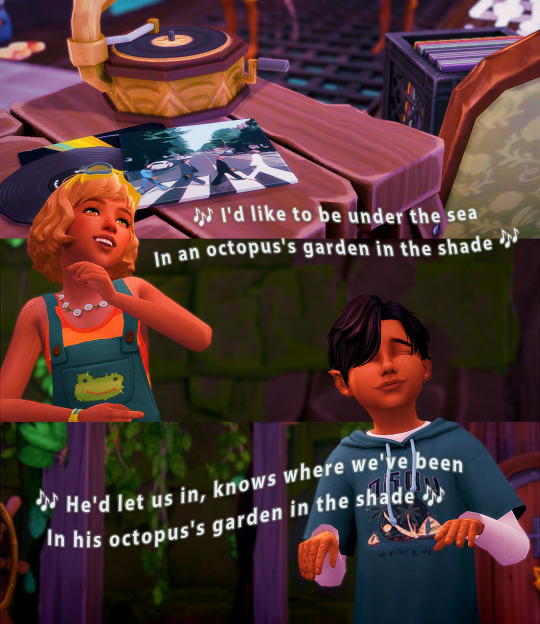
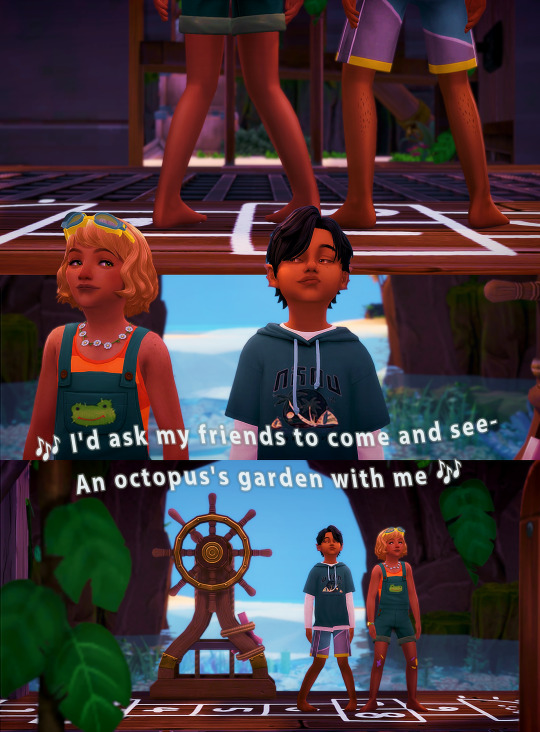


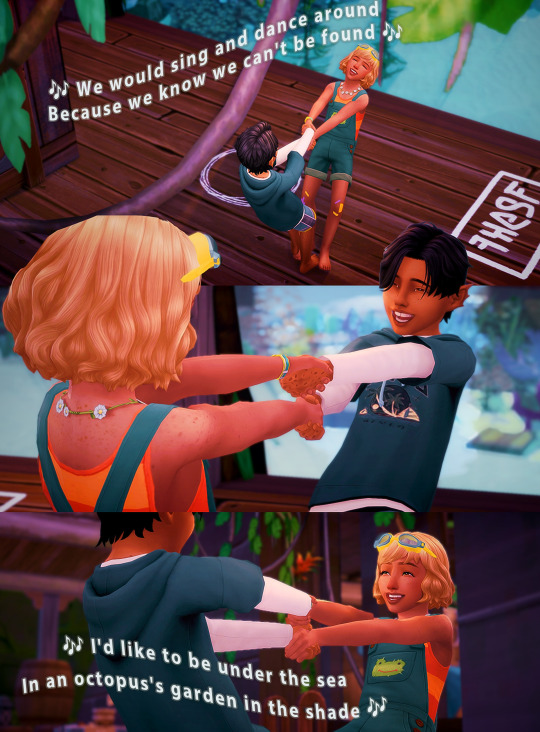

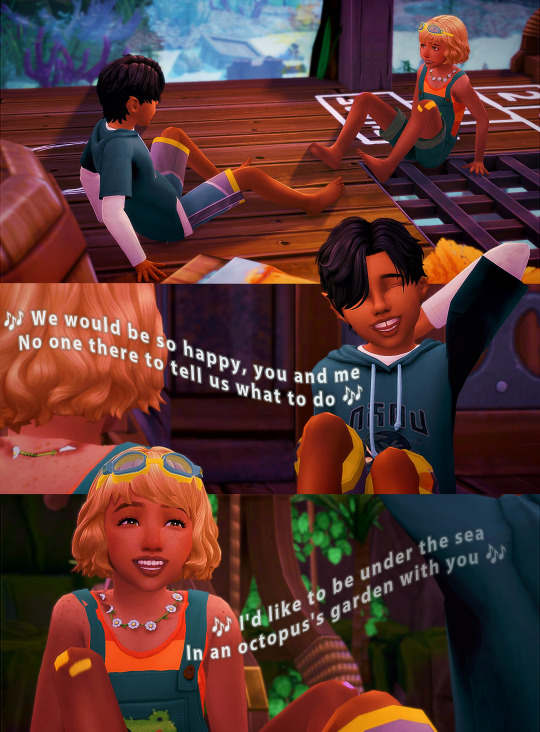
🐙🐠🐸
#theyre so BABY#got one more sequence and it's going in the q for tomorrow!#thanks for reading!#Plott Gen 6#Main Plott#Gen6Part5#Sunny Plott#HANSEL#Kāne Kanaloa
125 notes
·
View notes
Text
Kāne Weather systems
Akua Processes

Kāne
Kāne is a source of sunlight and energy, watching over environmental activities that occur due to the relationship of the earth and the sun.
water cycle
formation of clouds
the deepening of roots, and the growing of plants
natural phenomena such as lightning, thunder, rainbows
Kinolau of Kāne
Each form of Kāne provides something that we need as kānaka. These kinolau would be mea that give us sustenance, medicine, building materials, and ceremonial objects.
lāʻau, such as kalo, and kumu kukui
puaʻa, both for eating and ceremonial purposes
in some families, the pueo is a kinolau of Kāne
spring water, fresh water, brackish water
sunlight
coral
Kāne Systems in Waikīkī
In many different moʻolelo across the pae ʻāina of Hawaiʻi, two akua who went on countless adventures together are Kāne and Kanaloa. It is known that they had toured Hawaiʻi, swimming, eating and drinking ʻawa, and spouting up springs in different areas of each island; springs that are similar to those deeply connected to the meaning of Waikīkī’s name as a place of spouting waters. As the akua of fresh water, Kāne is connected to all the forces of nature that give us breath. Where Waikīkī was once a chiefly favorite for agriculture and fishing, Kāne is found in the sunlight, the agriculture, and the force that brings forth and sustains human life.
----------
sources
Kamehameha Publishing. “Kāne.” Kumukahi. Kamehameha Schools. Accessed November 9, 2020. http://www.kumukahi.org/units/ke_ao_akua/akua/kane.
Kanakaʻole Kanahele, Pualani. “Naoli.” Hilo: Edith Kanakaʻole Foundation, 2017.
Puniwai, Noelani, and Leimana Puʻu. Lecture. Akua Processes. Presented by the University of Hawaiʻi at Mānoa, 2020.
0 notes
Text
Waikīkī: Akua Processes and ʻŌlelo Noʻeau
11 November 2020 | HWST 356

Waikīkī, one of the many jewels of the Pacific. This southern coastline of the island of Oʻahu is home to one of the world’s most famous beaches, and some of the richest history. Once a place of lush vegetation and filled with fishponds, Waikīkī has since become a paradise catered to visitors, switching from a place of sustenance for locals, to a tourist destination. However, it is through stories and Hawaiian proverbs that we have access to another perspective of Waikīkī. When we look at our mythology and find our deities in the natural aspects of this place, we can connect to the land in a way that restores the old Waikīkī spiritually while we find ways to restore it physically.
Akua Processes at Waikīkī
In many different moʻolelo (stories) across the pae ʻāina (archipelago) of Hawaiʻi, two akua (deities) who went on countless adventures together are Kāne and Kanaloa. It is known that they had toured Hawaiʻi, swimming, eating and drinking ʻawa, and spouting up springs in different areas of each island; springs that are similar to those deeply connected to the meaning of Waikīkī’s name as a place of spouting waters. Kāne is the akua of fresh water, and is connected to all the forces of nature that give us breath. He is the sunlight, the kalo, and the force that brings forth and sustains human life. Kanaloa is also an akua of water. He is associated with the ocean, long distance voyaging, and healing, with the ocean itself thought to be one of his forms. Because of the relationship these akua have to bodies of water throughout Hawaiʻi, water is considered as one of the greatest gifts given to kānaka (humans) by akua and represents the gods themselves.
Originally, Waikīkī was a narrow ribbon of sand that lay between wetlands, fishponds, and a reef that stretched a few thousand feet wide. Several small streams flowed into the sea from the mountains, forming pockets of brackish water perfect for loko iʻa, or traditional Hawaiian fishponds. Wakīkī’s mixing waters not only made the area a rich and healthy farming ground, but also a sacred place frequented for physical and spiritual renewal. Chiefs and rulers of old Hawaiʻi, favored Waikīkī for its capacity to provide for its people. Waikīkī brought bountiful agriculture and ocean harvests for centuries, and infused the mana (spiritual power) of its caretakers who, in their relationships with their people and the ʻaina (land), watched over the different loʻi kalo (taro patched) and loko iʻa that were established in the area. Because of that mana, we’re able to see how the akua play their part in the creation of such a place, how their work sustained it in the past, and how some aspects are still present today.
Kāne himself is studied as a source of energy, an embodiment of the sun (as Kānehoalani) and oversees the creation of clouds. Environmental activities which occur due to the relationship of the earth and the sun, happen as a result of Kāne’s presence in the area. He and Kanaloa are expressed to be twins, both having the ability to embody one another. All that represents Kāne may also represent Kanaloa and vice versa, though they are still opposite in many ways. Where Kāne represents the Ao/Lā (the day), Kanaloa is the Pō (the night). Kāne is represented in Ke Ala Polohiwa a Kāne (Tropic of Cancer), and represents East and North. Kanaloa, on the other hand, represents the West and South and Ke Ala Polohiwa a Kanaloa (Tropic of Capricorn). Physically, it can be said that Kāne represents fresh water, and Kanaloa is the salt water. Waikīkī is representative of their convergence and relationship as twins, as it was historically a place where the mountains met the sea and where the fresh water from the uplands came down to meet the salt water of the ocean. That brackish water—the muliwai—is one of processes of Kāne and Kanaloa.
It would be incorrect to say that only Kāne and Kanaloa are present in the historic Waikīkī, as it has been explained that “where there is water, Laka can be found”. Laka is the Hawaiian akua of forests, hula, and reproductive energy. She is represented by the cycle of wai, the water cycle, which connects all deities. Her process is found in the evaporation of water molecules, and transpiration. Along with her partner Lono, Laka’s natural form takes place in the merging of water, and water being carried on the wind. Where “Lono water” descends, “Laka water” is upward moving. Lono is characteristic of wind and sound coming together, embodying wind as the air current that runs through and around all islands of Hawaiʻi. As Lewa Makua and Lewa Lani Lewa, Lono Makua is the stormy weather and lightning.
Stories of Place
As an ahupuaʻa, a section of land from mountain to ocean, Waikīkī is characteristic of all the above akua processes. We see this in the many mele and hula of Oʻahu, and in the countless ʻŌlelo Noʻeau (proverbs) connecting Waikīkī as a place of culture, tradition, and rich with history. While akua have their place in the physical and spiritual realms that oversee Waikīkī, they are not the only holders of moʻolelo. ʻŌlelo Noʻeau, proverbs and poetical sayings, have provided a unique look into the Hawaiʻi of our kūpuna (elders); Here is a collection of ʻŌlelo Noʻeau that tell stories of Waikīkī and of the traditional Hawaiʻi. They tell of fruitful beaches, fragrant limu and fish you could sense from paces away. “Nā līpōa ʻala o Kawehewehe” (#2255) talks about the fragrant līpōa seaweed of Waikīkī and specifically that of Kawehehwehe. Līpōa, a household name and often mentioned in song, was said to be so fragrant that one could smell it while standing on shore. It was even referred to as “ka iʻa hanu ʻala o kahakai” (#1332), a fragrant-breathed fish of the beach.
Waikīkī beaches are also known traditionally as a surfing hot spot even before the increased urbanization and tourist prioritization. There are various accounts of the old surfing culture, and they tell of a Hawaiʻi that belonged to Hawaiians, with all the cultural nuances known to kamaʻaina (native-born Hawaiians, locals). For instance, “ka nalu haʻi o Kalehuawehe” (#1493) talks about the rolling surf of Kalehuawehe at Waikīkī. It was so named when a legendary hero took off his lei (garland) of lehua blossoms and gave it to the wife of the ruling chief, with whom he was surfing. Another quote that talks of the favored surf at Kalehuawehe, is “e hoʻi ka uʻi o Mānoa, ua ahiahi” (#285); a saying meaning “let the youth of Mānoa go home, for it is evening”. It refers to the youth of Mānoa who used to ride the surf at Kalehuawehe in Waikīkī. The surfboards were shared among several people who would take turns using them, and those who finished first often suggested going home early, even though it might not be evening, to avoid carrying the boards to the hālau where they were stored. Later, this expression was used for anyone who went off to avoid work.
There are other proverbs that tell of an even older Waikīkī, during a time of wandering akua, strong chiefs and weary prophets. One proverb with connections to ancient Waikīkī reads, “e nui ke aho, e kuʻu keiki, a moe i ke kai, no ke kai la hoʻi ka ʻāina” (#363). This quote, meaning “take a deep breath, my child, and lay yourself in the sea, for then the land shall belong to the sea” is said to have been uttered by the Kahuna (priest) Kaʻopulupulu at Waiʻanae. Weary with the cruelty and injustice caused by Kahāhana, chief of Oʻahu, Kaʻopulupulu walked with his son to Waiʻanae, where he told his son to throw himself into the sea. The boy obeyed, and there died. Kaʻopulupulu was later slain and taken to Waikīkī where he was laid on the sacrificial altar at Helumoa. However, this moʻolelo Wakīkī doesn’t end here. “Ke one ʻai ʻaliʻi o Kakuhihewa” (#1772) tells of the chief-destroying sands of Kakuhihewa on the island of Oʻahu. When Kahuna Kaʻopulupulu was put to death by the chief Kahāhana for warning him against the cruelty to his subjects, he told a prophecy. He predicted that, where his own corpse would lie in a heiau (temple) at Waikīkī, there too would lie the chief’s corpse. Furthermore, like he had said to his son, Kaʻopulupulu foretold that the land would someday go to the sea—that is, to a people from across the sea. This was said to have been a curse. When Kamehameha III was persuaded by a missionary friend to move the capital from Lāhaina to Oʻahu, another Kahuna, remembering the curse, advised him not to, lest the monarchy perish. The warning was ignored, and before the century had passed, the Kingdom of Hawaiʻi was no more. With the end of the Hawaiian Kingdom, development continued on Waikīkī and more often than not, we lean on the stories of an old Hawaiʻi to remember the local surf, bountiful fishponds and sacred space that once made Waikīkī a favorite of chiefs and home to histories that came long before hotels.
sources:
Feeser, Andrea, and Gaye Chan. Waikiki: A History of Forgetting and Remembering. University of Hawaii Press, 2006.
Kamehameha Publishing. “Kanaloa.” Kumukahi. Kamehameha Schools. Accessed November 9, 2020. http://www.kumukahi.org/units/ke_ao_akua/akua/kanaloa.
Kamehameha Publishing. “Kāne.” Kumukahi. Kamehameha Schools. Accessed November 9, 2020. http://www.kumukahi.org/units/ke_ao_akua/akua/kane.
Kanakaʻole Kanahele, Pualani. “Naoli.” Hilo: Edith Kanakaʻole Foundation, 2017.
Pukui, Mary Kawena. 'Ōlelo No'eau: Hawaiian Proverbs and Poetical Sayings. Honolulu, HI: Bishop Museum Press, 1983.
Puniwai, Noelani, and Leimana Puʻu. Lecture. Akua Processes. Presented by the University of Hawaiʻi at Mānoa, 2020.
Wiegel, Robert L. "Waikiki Beach, Oahu, Hawaii: History of its Transformation From a Natural to an Urban Shore." Shore and Beach 76, no. 2 (2008): 3.
0 notes
Photo

Kāne is one of the four main gods in ka hoʻomana kahiko, traditional Hawaiian religion. The other three akua are Kū, Lono, and Kanaloa. Kāne plays a major role in the everyday life of a Hawaiian because Kāne is associated with the forces of nature that give us life. He is the sunlight. He is the fresh water. He is the kalo, the staple food of the Hawaiian race. Mele and moʻolelo designate Kāne as the force that brings forth and sustains human life... MAHALO NUI LOA LISA KAHELE FOR THIS BEAUTIFUL HAWAIIAN STORY LESSON 💙💯💙 (at Oahu, Hawaii) https://www.instagram.com/p/CCp07JQDOnGAJbAbyojicSfkh9HC2dOG1WOzyo0/?igshid=1e2vmmtj7w4kc
0 notes
Photo

for @fyeahmyths : Oceanian deity (day 13, two-week summer event)
Kanaloa: The Hawaiian God of the Ocean.In the traditions of ancient Hawaiʻi, Kanaloa is symbolized by the squid or by the octopus and associated with Kāne.
In legends and chants, Kāne and Kanaloa are portrayed as complementary powers (Beckwith 1970:62–65). For example, Kāne was called upon during the building of a canoe, Kanaloa during the sailing of it; Kāne governed the northern edge of the ecliptic, Kanaloa the southern; Kanaloa points to hidden springs, and Kāne then taps them out. In this way, they represent a divine duality of wild and taming forces like those observed.
Source: text (x)
182 notes
·
View notes
Note
Okay the tale of Maui’s death:
Maui was a celebrated demigod, a trickster and a respected hero for humanity. He had lassoed the sun and made the days longer so that people could enjoy the sunshine, grow their crops and dry their kapa. He used his fishhook to carry islands out from under sea so the people and the gods and akua could have a place to call their home. He killed the great eel and with its death created coconuts. So many things Maui had done that had benefited humans, he loved what he did. But he wanted to do more.
One day he saw that human father was getting weaker as the days and weeks past by. And he asked his father “father why do you grow weak with every sunrise and sunset?”
His father told him, “For I am getting old my son, death will grace me with its presence one day and there’s that can change that. For every thing that lives must die.”
And so Maui was inspired, for his next task, he would defeat death and and grant all of humanity the power of immortality. He told his father of his intentions and father warned him for death is eternal and no one could defeat death, Maui would fail if he dared to try. But Maui was confident, might I say arrogant, that he could complete the great task and grant humans with the gift of deathlessness. Knowing he would not be able to persuade his son out of this, the father told him the one rule of traveling to the goddess’s realm. “When you arrive at her abode, and cross the threshold into your home, you must enter her home the same way you entered this world, for any other adornment you wear into her realm will not only disgrace the goddess’s existence but also alert her and awake her from her slumber.” Taking in his father’s words, he quickly understood his words.
So he traveled until finally he found the spirit of life, an ancient akua, an ancestor of Maui, the goddess of life. For it was she that persisted the existence of death, and she layed sleeping in her realm far beneath the lands of the other great gods. She did not live in the heavens, with the gods Kāne or Wākea, she did not live amongst the humans like Pele and her siblings, she did not live in the realm of the great seas besides Kanaloa, nor did she preside in the land of the dead spirits where Milu, the akua of the underworld called home. She lives in a home where not even ther great gods and spirits dared to roam. For she lived at the edge of time, at the ending of the horizon in the west, where the sun sank beneath sea.
Sailing to the end of the horizon, he found the home of the goddess. The guardian of life lived amongst her own children, other spirits who danced across the island, waiting to protect their mother from and and all spirits that dared to cross her. In typical Maui fashion, Maui had found his way around the spirits and had successfully reached the threshold of the goddess’s home. Hiding behind the great larges trees and bushes, Maui befriended some beautiful and happy birds, and fed them fish he had brought for his journey, happy with the meals, one of the birds promised to lead Maui successfully to the goddess’s threshold. Together Maui and the bird watched in awe as they graced their eyes at the goddess’s home.
Realizing his father’s words, Maui remembered what he had to do. And so Maui began to strip. If he wanted to successfully enter the goddess’s home and kill her, he must do it while she was asleep, but he can’t do that if he entered her home with any weapons or clothes. So as he stripped, his new bird friend began to giggle, Maui quickly reprimanded the bird and said that if he laughed at Maui the goddess would wake up and kill him. Keeping his back faced towards his bird friend so that the bird wouldn’t laugh anymore at Maui’s nakedness. Maui and the bird then entered the goddess’s home.
It was dark, for the only light within the goddess’s home was the light that shines through her door. In front of Maui layed asleep the great goddess of life, a being great and large, as any other god or goddess who didn’t take on a human form. As he marched closer to the goddess, preparing the rio out her out and claim immortality for all of humanity, he turned around slightly as he looked at the goddess who slept, and his bird friend, who could help himself but laugh at Maui’s nakedness shrilled in laughter. The goddess, awakening in pure fury and ate the top half of Maui before he could even react. Silent went the bird, and silent Maui was forever more.
Thee end ✨✨✨
And that is how Maui died, for others reading this, please know that this was just the story I grew up with and across the pacific and definitely changing from island to island, from community to community the tale of Maui’s death is different. But yeah, thank you for reading ❤️🔥❤️🔥❤️🔥
Oh wow. Yeah that's a good ol foolish hero with good intentions death right there. Thank you, Laz. I hadn't known at all about this one and its wonderful that you didn't mind sharing once more. I wonder what the other iterations of his death are, I should look them up
Thank you as always!
2 notes
·
View notes